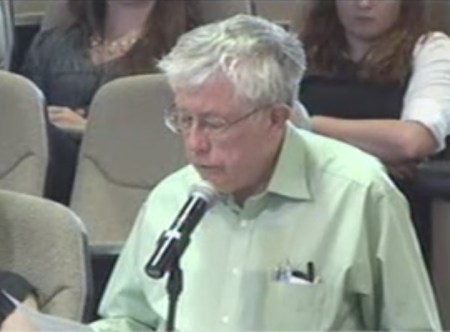
Project Connect’s wasteful plan — Ultra-pricey urban rail “decoration” in the wrong route
17 May 2014
Lyndon Henry speaking to Central Corridor Advisory Group, 16 May 2014. Screenshot from City of Austin video.
♦
By Lyndon Henry
The following comments were made during Citizen Communications to Project Connect’s Central Corridor Advisory Group on 16 May 2014. At the meeting, Project Connect’s Urban Rail Lead Kyle Keahey revealed the agency’s estimates and proposals regarding operating & maintenance costs, property valuation and tax revenue increases, funding, phasing issues, and “governance” (oversight and administration) the proposed 9.5-mile, $1.4 billion line connecting East Riverside (southeast) with the old Highland Mall site (north), currently under development as a new Austin Community College campus.
For months, Project Connect and Austin civic leaders have been considering subways, elevated lines, and other extravagant investments way out of scale for an urban rail starter line in a city of Austin’s size and density. The result is a $1.4 billion plan for urban rail linking a weak corridor, East Riverside, with a non-existent corridor, so-called “Highland”.
Meanwhile, Project Connect and the city’s leadership appear to have virtually abandoned the core neighborhoods, and heaviest local travel corridor, in the central city – Guadalupe-Lamar, where urban rail is desperately needed. The problem isn’t $1.4 billion for urban rail, it’s investing this money on what amounts to a very pricey decoration instead of addressing congestion with essential mobility.
At $119 million per mile in current dollars, Project Connect’s urban rail plan for Austin would be the third most costly light rail starter line in U.S. history, in terms of cost per mile. Compared with the previous Guadalupe-Lamar light rail project, planned until 2003, Project Connect’s plan costs 29% more than what that project would cost today, yet provides 35% less route length, and 47% fewer riders.

LEFT: Capital Metro 2000 urban rail plan included initial minimum operable segment (MOS) running 14.6 miles down Capital Metro railway, Lamar, and Guadalupe to CBD, plus 5.4 miles of extension down South Congress to Ben White and branch into East Austin. Total 20.0 miles of surface route (with adaptation of existing river bridge) would cost $1.2 million in current dollars ($60 million/mile). RIGHT: Project Connect plan proposes a 9.5-mile route from East Riverside, crossing river on new “signature” bridge, proceeding through east side of CBD, East Campus, along Dean Keaton and Red River to Hancock Center, then into open cut and tunnel, then along Airport Blvd. into Highland site. Total cost: $1.1 billion ($119 million/mile) in current dollars.
Stretching over 14 miles from McNeil along what’s now the MetroRail corridor, then down Lamar and Guadalupe to the CBD, that original starter line in today’s dollars would cost roughly $878 million, or about $60 million per mile, for 54% more miles of route. Ridership for 2025 was projected at 37,400 per day – 87% higher than the “high” 20,000 for Project Connect’s plan.
The next phase involved expanding into a larger 20-mile urban rail system for roughly $320 million more in today’s dollars, also amounting to about $60 million per mile. But that’s through the heart of central and south Austin, with over twice as much rail as Project Connect’s plan. By serving Austin’s highest-traffic, most populated, densest inner-city corridors, ridership was projected at 51,000 a day.
Project Connect and Austin’s leadership seem to have abandoned all thought of cost-effectiveness and seeking the best value for spending taxpayers’ money. Now they’re playing a game of magic tricks with operating-maintenance costs and dreams of a bonanza of real estate valuation increases.
But many Austin voters realize that lower ridership means higher operating subsidies from taxpayers. And while a tax rate increase is real, projections of future tax revenues are just projections — in other words, hopes and dreams.
Judging from Project Connect’s flawed, fairytale projections from last fall’s study process, Austin voters should view these hopes and dreams with strong skepticism.

Very well put, keep up the great commentary. The process seems to be falling apart. Hopefully some more thought and consideration can be put into this. What about an east riverside to guadalupe alignment? Maybe up to 51st?
[…] May 2014 Project Connect’s wasteful plan — Ultra-pricey urban rail “decoration” in the wrong route Lyndon Henry, a transportation planning consultant, is a technical consultant for the Light Rail […]
[…] • Project Connect’s wasteful plan — Ultra-pricey urban rail “decoration” in the wrong route […]